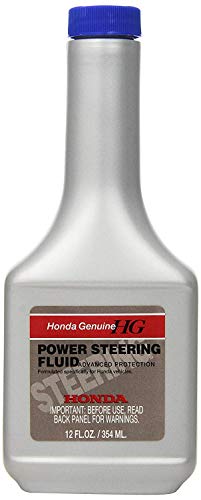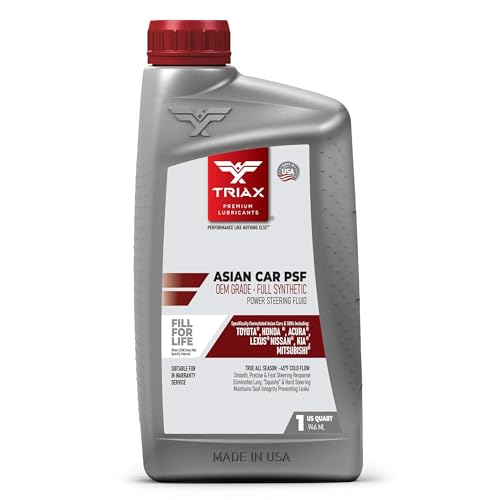When your power steering fluid runs low, you might wonder if you can use transmission fluid as a substitute. It’s a common question many drivers ask, and the answer could save you time and money.
Using the wrong fluid can lead to serious issues in your vehicle, so it’s crucial to understand the differences. We’ll dive into the details of power steering fluid and transmission fluid, exploring their roles and whether they can be used interchangeably.
By the end, you’ll know exactly what to do next time your power steering needs a top-up. Let’s get started!
Role Of Transmission Fluid
Transmission fluid plays an important role in vehicle performance. It helps with smooth gear shifts. This fluid also cools and cleans the transmission system. Understanding its functions can help you care for your car better.
Functions In A Vehicle
Transmission fluid serves several key functions. It lubricates the moving parts of the transmission. This reduces wear and tear over time. Good lubrication allows for smoother operation.
The fluid also transfers power from the engine to the wheels. This is crucial for shifting gears smoothly. It ensures that your vehicle responds well when you accelerate or decelerate.
Another vital function is cooling. Transmission fluid absorbs heat created during operation. This prevents overheating and helps maintain optimal performance.
Key Properties Of The Fluid
Transmission fluid has unique properties that make it effective. It is designed to resist high temperatures. This helps maintain its performance under stress.
The fluid also has good viscosity. This means it flows easily, providing better lubrication. It can adapt to different temperatures, ensuring consistent performance.
Lastly, transmission fluid includes additives. These help prevent rust and foam. They also improve the fluid’s overall performance and lifespan.
Purpose Of Power Steering Fluid
Power steering fluid plays a key role in vehicle steering. It helps drivers turn the steering wheel with ease. This fluid reduces friction in the steering system. It also protects the parts from wear and tear.
Without power steering fluid, steering becomes heavy and hard. Drivers may struggle to control the vehicle. This fluid makes driving safer and more comfortable. Understanding its purpose helps in maintaining your car’s performance.
How It Supports Steering
Power steering fluid helps in two main ways. First, it boosts the force applied by the driver. This makes turning the wheel much easier. Second, it transfers force from the steering wheel to the wheels.
The fluid flows through hoses and cylinders. It creates pressure that assists in steering. This means less effort is needed to turn. Smooth steering ensures better control of the vehicle.
Characteristics Of The Fluid
Power steering fluid has specific properties. It must resist high temperatures and pressure. This fluid also needs to lubricate moving parts. Good lubrication prevents damage and prolongs life.
The fluid should not foam or separate. Foaming can lead to steering issues. It must also remain stable over time. This stability ensures consistent performance.
Differences Between The Fluids
Understanding the differences between transmission fluid and power steering fluid is crucial. Each fluid serves a unique purpose. Using the wrong fluid can cause problems. Let’s explore the key differences.
Composition And Additives
Transmission fluid and power steering fluid have different compositions. Transmission fluid contains a mix of base oil and additives. These additives help with lubrication and temperature control.
Power steering fluid also has a unique formula. It includes a base oil, but its additives focus on reducing wear and improving performance. Some power steering fluids have anti-foaming agents. This helps keep the system working smoothly.
Compatibility With Systems
Using the right fluid is vital for system health. Transmission fluid is designed for transmissions. It can damage power steering systems if used incorrectly.
Power steering fluid, on the other hand, is formulated for steering systems. It helps with smooth steering and response. Mixing these fluids can lead to system failure.
Always check your vehicle’s manual. This will guide you on the correct fluid to use. Proper maintenance helps keep your vehicle running well.
Potential Risks Of Mixing Fluids
Using transmission fluid instead of power steering fluid can lead to problems. Many car owners may think they can use any fluid. This choice can harm your vehicle’s steering system. Understanding the risks is important for keeping your car safe.
Impact On Steering System
Mixing transmission fluid with power steering fluid can cause issues. These fluids have different properties. Transmission fluid is thicker and can create extra pressure. This pressure can damage seals and hoses in the steering system.
Also, transmission fluid does not have the same additives. These additives help with lubrication. Without proper lubrication, parts may wear out faster. Steering can become harder, making it unsafe to drive.
Long-term Effects On Performance
Using the wrong fluid can lead to long-term damage. Over time, the steering pump may fail. A failing pump can lead to costly repairs. It can also affect your car’s handling and safety.
Drivers may notice strange noises or reduced responsiveness. These are signs of trouble. Ignoring these signs can lead to bigger problems. Always use the right fluid for your vehicle’s needs.
When It’s Safe To Substitute
Many car owners face fluid issues. Power steering fluid can sometimes run low. Some wonder about using transmission fluid instead. Understanding when it’s safe to make this switch is important.
Using transmission fluid in place of power steering fluid may work in a pinch. Yet, it’s not a long-term solution. Knowing the right situations can help keep your vehicle safe.
Approved Scenarios
Using transmission fluid for power steering fluid is not a common practice. It may be acceptable in specific situations. For example, if you have no other options, it can work temporarily. But only use it until you get the right fluid.
Some older cars may not have strict requirements. In these cases, the fluids may be similar enough. Always double-check with a mechanic to be sure.
Manufacturer Guidelines
Always refer to your car’s manual first. Manufacturers provide clear guidelines on what fluids to use. Following these instructions is crucial for your vehicle’s health.
Some manufacturers explicitly state not to use transmission fluid. Ignoring this advice can lead to serious problems. It’s best to stick with the recommended power steering fluid.
Consult a professional mechanic if unsure. They can provide the best advice for your car. Keeping your vehicle in top shape is always the goal.
Signs Of Fluid Issues
Fluid problems can cause serious issues in your vehicle. Mixing transmission fluid with power steering fluid is not recommended. Signs of fluid issues include difficulty steering, unusual noises, or leaks under your car. Always use the correct fluid for each system to ensure safety and performance.
Recognizing the signs of fluid issues in your vehicle is crucial for maintaining its performance and safety. Transmission fluid and power steering fluid are essential for different functions, but sometimes, you may notice problems that could indicate fluid issues. Understanding these signs can help you prevent costly repairs and ensure a smooth driving experience.Warning Signs In Steering
You might feel a change in how your steering responds. If it becomes stiff or hard to turn, that’s a clear warning sign. Pay attention to any unusual noises when you steer. A whining or groaning sound could indicate low fluid levels or contamination. Additionally, if your steering wheel feels loose, you may be facing a serious issue. This can affect your control while driving.Common Symptoms Of Damage
Leaking fluid is one of the most obvious symptoms to watch for. Check under your vehicle for any puddles or spots. Changes in fluid color can also signal problems. Healthy power steering fluid is usually clear or light pink, while contaminated fluid may appear dark or milky. You might also notice that your steering feels delayed or unresponsive. This can make it difficult to maneuver your vehicle, especially in tight situations. Have you ever experienced any of these signs? Ignoring them could lead to more severe damage down the line. Keeping an eye on your fluid levels and addressing any issues early can save you time and money.Tips For Choosing The Right Fluid
Choosing the right fluid for your vehicle is important. Using the wrong fluid can cause damage. Power steering fluid and transmission fluid serve different purposes. Here are some tips to help you make the right choice.
Reading The Owner’s Manual
Your owner’s manual is a valuable resource. It contains specific information about your vehicle. Check which fluid type is recommended. Most manuals specify the correct power steering fluid. Following these guidelines helps maintain your vehicle.
Consulting A Professional
If you’re unsure, ask a professional. A mechanic can provide expert advice. They can check your system and suggest the right fluid. This is especially helpful for complex systems. Trust their experience to keep your vehicle running smoothly.
Frequently Asked Questions
What Happens If You Put Transmission Fluid Instead Of Power Steering Fluid?
Using transmission fluid instead of power steering fluid can damage the power steering system. Transmission fluid lacks the necessary additives for power steering, leading to reduced performance and potential leaks. Always use the correct fluid for optimal function and to avoid costly repairs.
What Can I Use Instead Of Power Steering Fluid?
You can use automatic transmission fluid (ATF) as an alternative to power steering fluid. Vegetable oil is another option, but it may not be as effective. Always check your vehicle’s manual for compatibility before making a substitution.
Can I Put Transmission Fluid On My Power Steering?
No, you should not use transmission fluid in your power steering system. Power steering requires specific fluid designed for its function. Using transmission fluid can cause damage and affect steering performance. Always refer to your vehicle’s manual for the correct fluid type.
Does Atf Transmission Fluid Work For Power Steering?
ATF transmission fluid can be used in some power steering systems. Check your vehicle’s manual to ensure compatibility. Using ATF may affect performance in systems designed for specific power steering fluid types. Always prioritize manufacturer recommendations for optimal results.
Conclusion
Using transmission fluid for power steering fluid is not recommended. Each fluid has a specific purpose. Mixing them can cause problems. Power steering systems need the right fluid for proper operation. Always check your vehicle’s manual. It will tell you what fluid to use.
Using the wrong fluid can lead to costly repairs. Stick with the recommended fluid for safety and performance. This small step can save you trouble in the long run. Keep your vehicle running smoothly by choosing the right fluids.

Benjamin Grey is an automotive engineer and writer at Car Parts Advisor. With years of experience in the automotive industry, he shares expert advice on car parts, maintenance, and repairs to help car owners keep their vehicles running smoothly.



